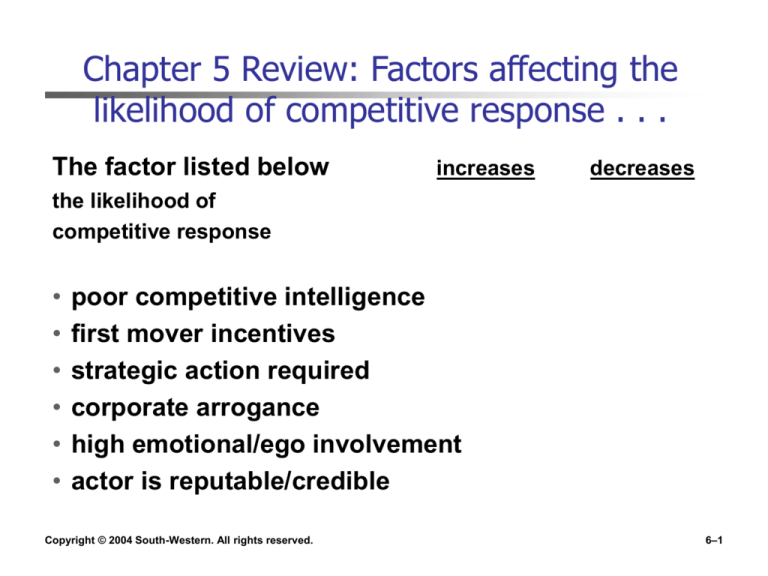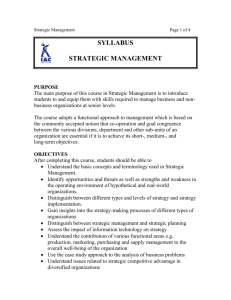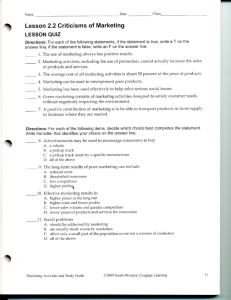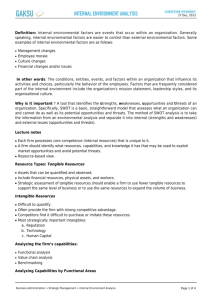
Chapter 5 Review: Factors affecting the
likelihood of competitive response . . .
The factor listed below
increases
decreases
the likelihood of
competitive response
•
•
•
•
•
•
poor competitive intelligence
first mover incentives
strategic action required
corporate arrogance
high emotional/ego involvement
actor is reputable/credible
Copyright © 2004 South-Western. All rights reserved.
6–1
The Strategic
Management
Process
Figure 1.1
Copyright © 2004 South-Western. All rights reserved.
6–2
Chapter 6: Corporate-Level Strategies
• Corporate-level strategies;
advantages and disadvantages of each
- single business
- dominant business
- vertical integration
- related diversification
(activity sharing and skill transfer)
- unrelated diversification
(capital reallocation; restructuring)
• Core business
Copyright © 2004 South-Western. All rights reserved.
6–3
Corporate-level strategy encompasses the
entire organization;
Business-level strategy is at the
____________ level
PepsiCo
Soft Drinks
Copyright © 2004 South-Western. All rights reserved.
Frito-Lay
Tropicana
6–4
Two Strategy Levels
• Business-level Strategy (Competitive)
Each business unit in a diversified firm chooses
a business-level strategy as its means of
competing in individual product markets
• Corporate-level Strategy (Companywide)
Specifies actions taken by the firm to gain a
competitive advantage by selecting and
managing a group of different businesses
competing in several industries and product
markets
Copyright © 2004 South-Western. All rights reserved.
6–5
Corporate-Level Strategy: Key Questions
• Corporate-level Strategy’s Value
The degree to which the businesses in the
portfolio are worth more under the management
of the company than they would be under other
ownership
What businesses should
the firm be in?
How should the corporate
office manage the
group of businesses?
Business Units
Copyright © 2004 South-Western. All rights reserved.
6–6
Some Corporate-Level Strategy Questions:
• McDonald’s Chipotle Grill? C-stores? hotel? rec center?
• Ebay purchase of Skype internet phone provider?
• John Deere & Company wholesale landscaping business?
• Ford Motor Company Hertz Rent-A-Car?
• New York Times ownership of papermills?
Copyright © 2004 South-Western. All rights reserved.
6–7
“few corporate-level strategies actually
create value . . . “ - pg. 170
Yet again,
strategy formulation might be easier than
strategy implementation!
Synergies (where the whole is greater than
the sum of the parts) are easier to
conceptualize than to actually realize.
Copyright © 2004 South-Western. All rights reserved.
6–8
Levels and Types of Diversification
Figure 6.1
SOURCE: Adapted from R. P. Rumelt, 1974, Strategy, Structure and Economic Performance, Boston: Harvard Business School.
Copyright © 2004 South-Western. All rights reserved.
6–9
Common evolution pattern of
corporate-level strategies
• Single business
• Dominant business
• Vertical integration
• Vertical integration with by-products
diversification
• Related-constrained diversification
• Related-linked diversification
• Unrelated diversification
• Related-constrained diversification
Copyright © 2004 South-Western. All rights reserved.
6–10
Single- and Dominant- Business Strategy
Advantages
Copyright © 2004 South-Western. All rights reserved.
Disadvantages
(Why move away from
these strategies toward
diversification?)
6–11
Vertical Integration Strategy
When a firm produces its own inputs =
__________________ integration
When a firm owns its own means of
distribution = ________________ integration
Copyright © 2004 South-Western. All rights reserved.
6–12
Forward and Backward Vertical Integration
Forward vertical integration
supplies
manufacturing
distribution
retail
Backward vertical integration
Copyright © 2004 South-Western. All rights reserved.
6–13
Vertical Integration Strategy
Advantages/
Reasons for Use
Copyright © 2004 South-Western. All rights reserved.
Disadvantages/Hazards
6–14
Alternatives to Vertical Integration?
Copyright © 2004 South-Western. All rights reserved.
6–15
Diversification Strategy =
participation in >1 industry (segment),
structuring into separate divisions,
with no single division contributing
>70% of sales revenue
Johnson & Johnson
Consumer Products
18% of sales;
13% of operating profit
Pharmaceuticals
47% of sales;
61% of operating profit
Copyright © 2004 South-Western. All rights reserved.
Devices and Diagnostics
35% of sales;
26% of operating profit
6–16
Diversification Strategy
Advantages
Copyright © 2004 South-Western. All rights reserved.
Disadvantages/Pitfalls
6–17
Strategic Motives for Diversification
To Enhance Strategic Competitiveness:
• Economies of scope (related diversification)
Sharing activities
Transferring core competencies
• Market power (related diversification)
Blocking competitors through multipoint competition
(Vertical integration)
• Financial economies (unrelated diversification)
Efficient internal capital allocation
Business restructuring
Table 6.1a
Copyright © 2004 South-Western. All rights reserved.
6–18
Incentives and Resources for Diversification
Incentives and Resources with Neutral
Effects on Strategic Competitiveness
• Antitrust regulation
• Tax laws
• Low performance
• Uncertain future cash flows
• Risk reduction for firm
• Tangible resources
• Intangible resources
So - these are not the best reasons to diversify!
Table 6.1b
Copyright © 2004 South-Western. All rights reserved.
6–19
Managerial Motives for Diversification
Managerial Motives (Value Reduction)
• Diversifying managerial employment risk
• Increasing managerial compensation
“managerial opportunism” (Chapter 10)
Table 6.1c
Copyright © 2004 South-Western. All rights reserved.
6–20
The Curvilinear Relationship between
Diversification and Performance
Figure 6.3
Copyright © 2004 South-Western. All rights reserved.
6–21
Related Diversification
• Firm creates value by building upon or
extending its:
Resources
Capabilities
Core competencies
Copyright © 2004 South-Western. All rights reserved.
6–22
Best resource/capabilities for diversification
are typically found in a firm’s core business:
“Core business”
represents the business unit or division
containing the firm’s most developed skills;
often can be identified by
• high proportion of firm’s profit
• high proportion of a firm’s assets
• original business of the firm
• division serving primary target markets
Copyright © 2004 South-Western. All rights reserved.
6–23
Related Diversification - Economies of Scope
• Value is created by extending important
resources/capabilities/core competencies
through:
Operational relatedness in sharing activities -
value chain activities are shared among units
Corporate relatedness in transferring skills competencies are transferred across units
Copyright © 2004 South-Western. All rights reserved.
6–24
In related diversification:
implementation to realize synergies Example of PepsiCo
Shared Activities
(operational relatedness)
• distribution
• sales
• market research
Copyright © 2004 South-Western. All rights reserved.
Skill Transfer
(corporate relatedness)
• product development
• brand development
• brand excitement
6–25
Activity sharing and skill transfer . .
• can create efficiencies (especially activity
sharing)
• can provide competitive advantages that are
valuable, rare, and difficult to imitate due to
complexity and combining tangible and
intangible resources
• can fail due to implementation
complications - managed interactions
across business units are required
Copyright © 2004 South-Western. All rights reserved.
6–26
Advice for sharing activities
or transferring skills
Since sharing activities and transferring skills
adds management complications,
only select those that are
competitively meaningful, with strong
potential to add competitive advantage,
or it generally isn’t going to be
worth the trouble!
Copyright © 2004 South-Western. All rights reserved.
6–27
Unrelated Diversification
• Financial Economies
Are cost savings realized through improved
allocation of financial resources
Create value through two types of financial
economies:
Efficient internal capital allocation
Purchasing other corporations and
restructuring their assets
Copyright © 2004 South-Western. All rights reserved.
6–28
Unrelated Diversification Efficient Internal Capital Market Allocation
Acquire sound, attractive autonomous
companies that need growth capital
Corporate office distributes capital from low
growth divisions to high growth divisions to
create value for overall company
Operation like an “internal capital market”
Corporate
office gains proprietary access to
information about those businesses’ actual
and prospective performance
Copyright © 2004 South-Western. All rights reserved.
6–29
Otter Tail Corporation - partial view
Otter Tail Corporation
Electricity
30% of sales revenue;
75% of net income
Manufacturing
26% of sales revenue;
16% of net income
Copyright © 2004 South-Western. All rights reserved.
Health Services
13% of sales revenue;
7% of net income
6–30
Unrelated Diversification: Restructuring
• Restructuring creates financial economies
A firm creates value by buying and selling other
firms’ assets in the external market
The idea is basically, “buy low, sell high”
“The corporate fixer-upper” - buy
underperforming firms or units, fix the problems,
and sell for a higher price
Copyright © 2004 South-Western. All rights reserved.
6–31
Unrelated Diversification Implementation Considerations
• Can be considered easier to implement than
related diversification
• No required commonalities and/or
interactions between units
• Each unit is basically “stand-alone”, and
operates independently of the other units,
except for centralized resource allocation
Copyright © 2004 South-Western. All rights reserved.
6–32
Unrelated Diversification:
Performance Reputation
• “diversifiction”
• “diworseification”
• the conglomerate discount
• conclusion = unrelated diversification
generally produces poor performance
Copyright © 2004 South-Western. All rights reserved.
6–33







